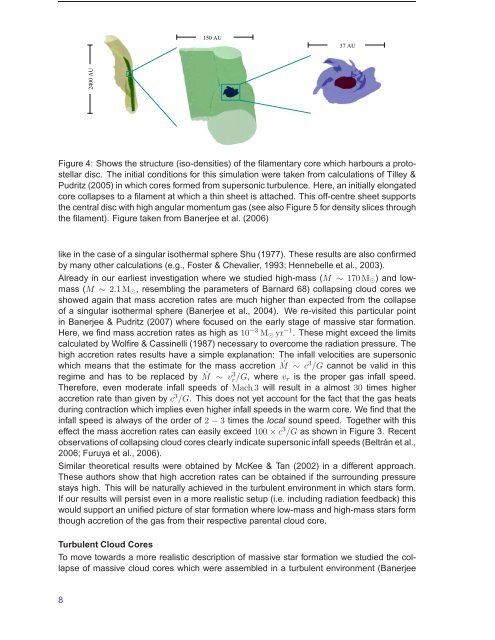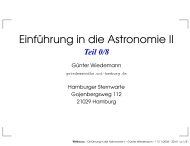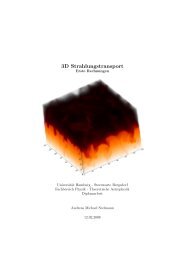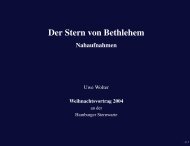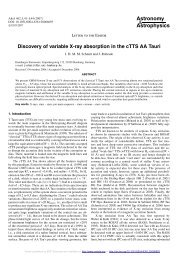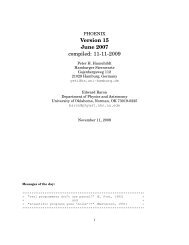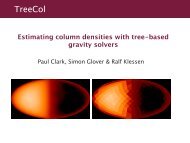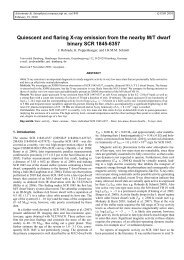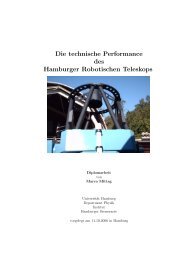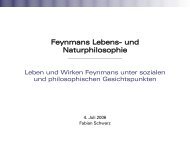Emmy Noether Application
Emmy Noether Application
Emmy Noether Application
You also want an ePaper? Increase the reach of your titles
YUMPU automatically turns print PDFs into web optimized ePapers that Google loves.
2400 AU<br />
150 AU<br />
Figure 4: Shows the structure (iso-densities) of the filamentary core which harbours a protostellar<br />
disc. The initial conditions for this simulation were taken from calculations of Tilley &<br />
Pudritz (2005) in which cores formed from supersonic turbulence. Here, an initially elongated<br />
core collapses to a filament at which a thin sheet is attached. This off-centre sheet supports<br />
the central disc with high angular momentum gas (see also Figure 5 for density slices through<br />
the filament). Figure taken from Banerjee et al. (2006)<br />
like in the case of a singular isothermal sphere Shu (1977). These results are also confirmed<br />
by many other calculations (e.g., Foster & Chevalier, 1993; Hennebelle et al., 2003).<br />
Already in our earliest investigation where we studied high-mass (M ∼ 170M⊙) and lowmass<br />
(M ∼ 2.1M⊙, resembling the parameters of Barnard 68) collapsing cloud cores we<br />
showed again that mass accretion rates are much higher than expected from the collapse<br />
of a singular isothermal sphere (Banerjee et al., 2004). We re-visited this particular point<br />
in Banerjee & Pudritz (2007) where focused on the early stage of massive star formation.<br />
Here, we find mass accretion rates as high as 10 −3 M⊙ yr −1 . These might exceed the limits<br />
calculated by Wolfire & Cassinelli (1987) necessary to overcome the radiation pressure. The<br />
high accretion rates results have a simple explanation: The infall velocities are supersonic<br />
which means that the estimate for the mass accretion ˙ M ∼ c 3 /G cannot be valid in this<br />
regime and has to be replaced by ˙ M ∼ v 3 r /G, where vr is the proper gas infall speed.<br />
Therefore, even moderate infall speeds of Mach 3 will result in a almost 30 times higher<br />
accretion rate than given by c 3 /G. This does not yet account for the fact that the gas heats<br />
during contraction which implies even higher infall speeds in the warm core. We find that the<br />
infall speed is always of the order of 2 − 3 times the local sound speed. Together with this<br />
effect the mass accretion rates can easily exceed 100 × c 3 /G as shown in Figure 3. Recent<br />
observations of collapsing cloud cores clearly indicate supersonic infall speeds (Beltrán et al.,<br />
2006; Furuya et al., 2006).<br />
Similar theoretical results were obtained by McKee & Tan (2002) in a different approach.<br />
These authors show that high accretion rates can be obtained if the surrounding pressure<br />
stays high. This will be naturally achieved in the turbulent environment in which stars form.<br />
If our results will persist even in a more realistic setup (i.e. including radiation feedback) this<br />
would support an unified picture of star formation where low-mass and high-mass stars form<br />
though accretion of the gas from their respective parental cloud core.<br />
Turbulent Cloud Cores<br />
To move towards a more realistic description of massive star formation we studied the collapse<br />
of massive cloud cores which were assembled in a turbulent environment (Banerjee<br />
8<br />
37 AU


